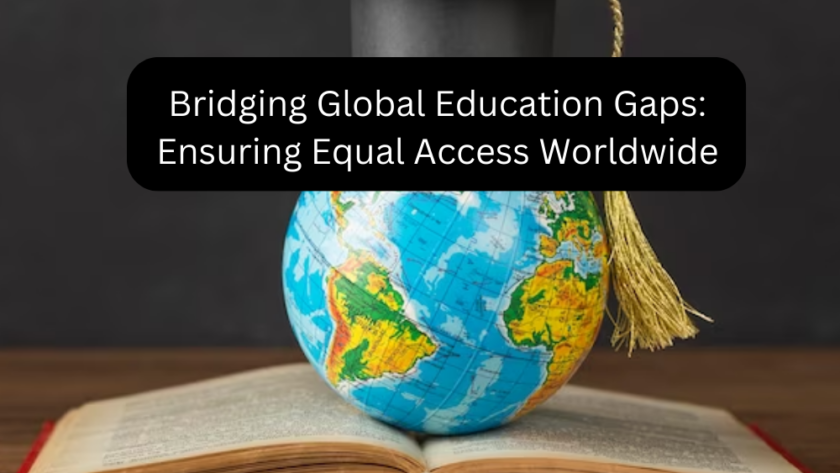What: The article is about the global education gap. It pinpoints and explains the reasons behind this disparity and offers suggestions for narrowing the achievement gap.
Why: To address issues related to the global education gap and comprehend current initiatives aimed at closing the gap.
Both developed and developing nations are impacted by the global education divide. Although it is difficult, bridging the education gap is crucial to attaining sustainable development. Businesses, governments, and civil society organizations have to collaborate to accomplish this.
Understanding Education Gap
The education gap refers to disparities in educational attainment. Several factors such as socioeconomic status, gender, location, access to technology, ethnicity, and disabilities, can have a significant impact on it. Access to education is the fundamental right of all human beings, regardless of their ethnicity, gender, or location. Equal access to education may
- Foster Equality
- Breakthrough poverty
- Drive economic growth
- Enhance social mobility
- promote diversity and inclusion
Governments, organizations, and communities must unite to bridge the global education gap. Here are some examples of how the global education gap and education inequalities are linked
- Only 66% of children in Saharan Africa complete lower secondary school. Whereas, 91% of children complete lower secondary school in high-income countries.
- Boys in low-income countries are 1.5 times more likely to complete school than girls.
- Children living in rural areas are 1.5 times more likely to be out of school than children living in urban areas.
The global education gap creates an unequal distribution of education. Many factors cause inequality in education.
Root Causes Of Education Inequality
Educational inequality affects the development of both individuals and societies. It refers to the unequal distribution of education opportunities. Addressing these basic causes is important to bridge the education gap.
Some of the key factors that cause educational inequality are:
1. Poverty
Poverty stands as the primary and most common cause of education inequality. It contributes to limiting access to quality education for many individuals. Some of the factors that link poverty to education inequality are:
- Limited access to education resources,
- Housing instability,
- Overcrowded and underfunded schools,
- Less access to technology
2. Racism And Discrimination
Racism and discrimination influence the persistence of educational inequality. These biases can lead to unfair opportunities and results. Some of the factors that link education inequality with racism and discrimination are
- Unequal access to education resources.
- Bias in curriculum and teaching.
- Disciplinary disparities.
- Bias in testing.
3. Social Class
Social status highly influences educational inequality. Lower social classes often experience lower educational success and efficiency. The causes of this are
- Limited connection.
- Lack of early childhood education.
- Limited access to technology.
- Funding disparities.
4. Teaching Quality And School Management
Teaching quality and school management shape the educational experience. Students from low-income backgrounds suffer significantly from poor teaching quality and school management. The causes of this are
- Inexperienced teachers
- Overcrowded classrooms
- Inadequate infrastructure
- Lack of mentorship
Addressing these challenges requires investment in teacher training, reducing class sizes, improving infrastructure, promoting mentorship programs, and ensuring equitable access to quality physical education. By addressing these issues, we can strive to create a more inclusive and supportive educational environment for low-income students.
5. Language Barrier
The language barrier limits students’ ability to perform well academically. Students struggling with teaching languages are at risk of not receiving quality education. Here is how language barriers cause education inequality.
- Reduced academic performance
- Limited comprehension
- Low confidence
- Limited participation in extracurricular activities
6. Gender
Gender-based disparities in education remain a significant contributor to education inequality. Primarily affecting girls and women, gender-based discrimination is a global concern. Some key ways in which gender becomes the root cause of education inequality are:
- Social norms and stereotypes
- Early marriage and pregnancy
- violence and safety concerns
- Parental priorities
Bridging The Education Gap On A Global Scale
Globally, there exists an education gap that deprives millions of individuals of their education rights. To address this issue, we must consider a multifaceted approach. Here are some approaches that will close some gaps in education.
1. Technology in Education
Technology plays a significant role in bridging the education gap. Technology in education directs the use of digital tools in learning and teaching processes. This makes education more interactive, accessible, and efficient.
Digital learning helps children have greater opportunities for learning and earning. It provides the choice to build the literacy, numeracy, digital, future life, entrepreneurial, and job-specific skills they need.
2. Gender Equality and Inclusiveness in Education
There are still gender disparities in many parts of the globe. Social norms and traditional gender roles limit Girls’ attendance at school in some remote areas.
The initial phase in reducing the global education gap is to support gender equality and inclusion in education. To achieve this, an environment where, regardless of gender everyone has equal access to education. These issues must be addressed to protect girls who face gender-based violence in the education environment.
Read: The Benefits and Challenges of Online Education
3. Teacher Training and Quality
Developing teachers’ quality through training is crucial for improving education quality and reducing the education gap. Well-trained teachers can encourage and motivate students correctly which ultimately improves education quality and reduces the education gap.
The physical and mental health of teachers is vital. As a result, it’s critical to guarantee that the instructors’ health is appropriately maintained. Teaching experiences might be negatively impacted by a teacher’s level of tiredness. Similarly, acknowledging and rewarding educators helps maintain their dedication and drive, which raises the caliber of instruction.
4. Access to Infrastructure
The foundational step to reducing the educational gap is Improving infrastructure and access. This gives students the proper possibility to access quality education. The government should focus on constructing and maintaining well-equipped school buildings. This includes proper sanitation facilities and up-to-date teaching and learning technologies. Similarly, providing safe and affordable transportation can improve access to education.
5. Socio-economic and Cultural Factors
Understanding and addressing socioeconomic and cultural factors is crucial for fair access to quality education. It is important to implement policies and plans to bridge the education gap.
Children from economically disadvantaged backgrounds should be provided with scholarships, financial support, and resources. This ensures they have the same opportunities in education as their peers. Similarly, schools must respect and incorporate culturally relevant curricula that resonate with students from various backgrounds. Bilingual education programs are essential to ensuring students have a fair chance in the education system.
International Initiatives for Education Equality
Numerous organizations and institutions are carrying out global campaigns for educational equality. Some of the initiatives are:
- UNESCO’s Strategy for gender equality in and through Education focuses on a system-wide transformation to benefit all learners equally
- Google.org’s $110 million initiative to help close gaps in education focuses on giving more students access to quality learning materials, supporting teacher development, and reaching students in conflict zones.
- UNESCO’s Transforming Education Summit (TES) aims to mobilize cross-country cooperation, address urgent post-recovery needs, and pave the way for the transformation of education systems.
Conclusion
Inequalities in educational attainment stem from the global education gap, influenced by socioeconomic status, gender, location, access to technology, and disability. Closing this gap ensures fair access to quality education and serves as an instrument for promoting inclusion and diversity, breaking the cycle of poverty, fostering equality, and driving economic progress. Bridging the gap relies on collective efforts from businesses, government, society, and individuals to work toward a world where equal access to quality education is a fundamental right for every human being. Bridging the education gap is not just an aspiration; it is a necessity for a brighter future.
Academic-session offers the most innovative learning portal. Get complete insight into online courses and career development.
FAQs
- What are the main Global education gaps?
The main Global Education Gaps include- Access to Education
- Quality of Education
- Gender Disparities
- Language Barriers
- What is the role of technology in education equality?
Technology can play a revolutionary and complicated role in improving educational equity. Some key elements of technology’s role in advancing educational equity are:
- Accessibility
- Personalization
- Global collaboration
- Digital Literacy
- How can businesses support global education initiatives?
Businesses can support global education initiatives in several ways. Some of them are:
- Internships and Job opportunities
- Financial Support
- Skills-Based Volunteering
- Mentorship Programs
Author’s Bio:
Grace Walker is a professional content writer passionate about creating fascinating narrative content at CDR Engineers Australia. With vast experience in generating engaging blogs, he consistently provides informative, accessible, and verified content that benefits anyone.




